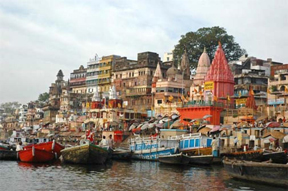 One of the most revered religious destinations
One of the most revered religious destinations
Varanasi, also renowned as Kashi and Banaras, is located in the state of Uttar Pradesh, India. The holy city, believed to be have been founded by Lord Shiva about 5000 years ago, is placed picturesquely on the west bank of Holy Ganges River and is one of the most revered religious destinations in India.
Varanasi has got its name from two rivers Varuna located at the north and Assi located at the south of the city. This place has got its mention in the holy epics Ramayana and Mahabharata.
The importance of Varanasi (Kashi) lies in the religious belief that those who die in the area in the Kashi city bounded by the Panch Kashi Road will attain the salvation. The city is thronged by thousands of Hindu devotees every day throughout the year. Any Hindu believer in the country and abroad is a devout aspirant of visiting Kashi at least once in life time.
The place is also renowned as a place for performing last rites for the believers and the mortal remains are immersed in the water of Ganges in Kashi. Performing funeral rites and cremation in the pyres are very usual scenes on the banks of river Ganges in Varanasi. Many people like to spend the fag end of their life in this holy city and like to attain salvation here.
There are many attractions in Varanasi. It is an ideal spot for those travelers who are enthused about the Hindu beliefs, customs, cultures and concepts. They can have the real life experiences of Hindu way of living and belief in rebirth.
Varanasi is also famed as a centre of silk weaving and worthy silk apparels. The Paan, mixture of betel leaves, arecanut, tobacco and lime, is a favorite chewing item in Varanasi.
The lush green vegetation on the banks of the river is very attractive. The place is enriched with many ancient temples like Kashi Vishwanath Temple, Kal Bhairava temple, Durga Kund and Annapoorna temple. Varanasi is a prime centre of art, craft, education and culture. Many philosophers and scholars had been in Varanasi to understand the divine life style of Hinduism and virtues of Hindu beliefs. Buddha, Mahavir, Adi Shankaracharya and Acharya Ramanuja spent lot of their time on the banks of Ganges in Kashi.
Attractions
Ramnagar Fort: Ramnagar Fort, constructed by Maharaja Balwant Singh in 17th century, is a medieval period fort located on the banks of the river. This was the royal residence of Raja of Banares, also known as Maharaja of Kashi.
Ramnagar Museum: The scholarly museum, renowned as the Banaras Vidya Mandir Museum, is located inside the Ramnagar Fort. It is home of many medieval period artifacts, items belonged to the Royal family of Banaras and also many handicraft items.
Alamagir Mosque: Alamgir Mosque, built by the Mughal Emperor Aurangzeb, has the unique distinction of being the largest structure located on the banks of river Ganges. It is believed that the mosque is placed at a place where a majestic Krishna temple was located.
Assi Ghat: Asi Ghat, the Ghat located at the confluence of Assi River and the holy Ganges, is the southernmost Ghat in Kashi. The Ghat is renowned for a spectacular and large Shiva Lingam placed under a Peepal Tree. This is a favorite spot for Hindu devotees to offer their prayers to Lord Shiva after taking holy dip in the river.
Darbhanga Ghat: Darbhanga Ghat, a renowned holy spot among Hindu devotes, is an ideal location to have religious rites associated with death of the relatives or friends. It is situated on the bank of the Ganges between two other Ghats, famous as Dashaswamedh Ghat and Rana Mahal Ghat.
Dasaswamedh Ghat: Dashaswamedh Ghat, a much acclaimed religious spot, is a favorite among Hindu devotees and is considered as the main Ghat. It is believed that Lord Brahma performed his victorious Dasa-Ashwamedha (ten-horses) sacrifice in this spot.
Durga Temple: Brahmacharini Durga Temple is located near Durga Ghat (Durga Kund) on the banks of the holy river. The prime deity is Goddess Durga in imposing structure. The temple, built in 18th century by a Bengali Maharani, is one of the most revered temples in Varanasi. The temple was constructed with many storied Shikhara, placed one over the other. The temple structure is imposing and offers a spiritual ambiance to the environment.
Gyan Kup: Gyan Kup or Gyan Vapi Well is an acclaimed religious spot in Varanasi. The name literally means well of wisdom. Gyan Vapi well, an imposing pavilion, is located at the entrance to the renowned holy Kashi Vishwanath temple.
Hanuman Ghat: Hanuman Ghat, earlier known as Ramesvaram Ghat, is situated at a holy spot famed as Juna Akhara in Varanasi. Legends say that this Ghat was built by Lord Ram himself and hence this Ghat is dedicated to Lord Hanuman, the most favored disciple of Lord Ram.
Kashi Vishwanath Temple: The chief deity for whom the whole city of Varanasi is dedicated is Kashi Vishwanath, one of the manifestations of Lord Shiva. The presence of Kashi Vishwanath Temple makes Varanasi as the most sacred city in India.
Kedar Ghat: Kedar Ghat is the favored temple among south Indians and Bengalis. It is a revered Ghat in Varanasi. It was constructed by the Maharaja of Vijayanagar in the southern part of Kashi. The temple dedicated to Lord Shiva (Kedarnath) is the unique feature of this place.
Man Mandir Ghat: Man Mandir Ghat, dating back to 1600 and renovated in 19th century, was built by Raja Savai Man Singh and the Ghat is named after him. Man Mandit Ghat, originally known as Somesvara Ghat, has a fine balcony at the north end of the Ghat.
Manikarnika Ghat: Manikarnika Ghat, also known popularly as Mahasmasana, is one of two burning Ghats in Varanasi. The other Ghat where burning is allowed is Harishchandra Ghat. Manikarnika Ghat is the prominent among the two and dates back to many centuries.
New Vishwanath Temple: New Vishwanath Temple, also popularly known as the Golden Temple, is situated in the campus of Banares Hindu University (BHU). The temple was built by the Birla family and hence it is also known as Birla temple.
Panchganga Ghat: Panchganga Ghat, is a sacred Ghat located at the confluence of five holy rivers. The rivers are The Ganga, The Saraswati, The Dhupapapa, The Yamuna and The Kirna. This Ghat is a major Hindu religious attraction in Varanasi.
Rana Ghat: Rana Mahala Ghat, was built in 1670 AD by the Udaipur ruler during that period and is located at the western side of Varanasi. The Ghat is perfectly placed on the banks of Ganges so that one can perform all religious rituals without much difficulty and can have a holy dip in the Ganges waters. This place is often visited by the Hindu devotees to perform purification of the mind and body.
Best time to visit Varanasi: Varanasi has a humid subtropical climate with much variation in temperatures. Tourists should visit this city during the months from October to March.
How to reach
By Train: Varanasi is well connected with all major railway stations in India. There are two railheads nearby, namely Varanasi junction and the Kashi junction. Many express trains connect Varanasi with Delhi and Kolkata.
By Air: Varanasi airport is connected to Delhi, Mumbai and Agra. International travelers can get connecting flights from Delhi, which is 755 km away.
By Bus: State owned public bus services connect Varanasi with other holy cities in Uttar Pradesh and neighboring states.






